This was published 2 years ago
‘More of an effect than you can imagine’: Restoring Notre-Dame’s ancient acoustics
Four years after a devastating fire tore through the famed Paris cathedral, the quest is on to rediscover the sounds of its past.
By Madeleine Schwartz
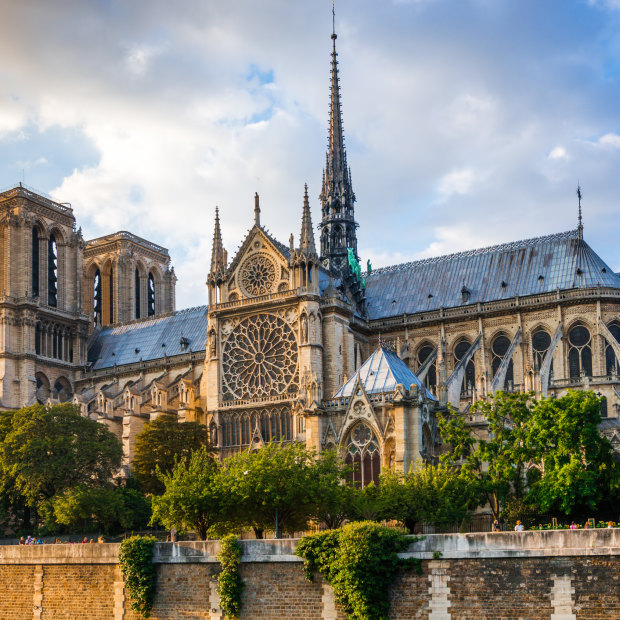
Notre-Dame, viewed from the south. Many major monuments were built to please our ears. “The experience of the space of worship brought together all the senses, sight and hearing,” says one historian.Credit: Getty Images
When I visited Notre-Dame in the spring of 2021, the whole space seemed to be ringing. The sounds were coming not from the cathedral’s chorus or its organs but from the workers rushing to repair the building, much of which was destroyed by a fire in April 2019. Everywhere were scaffolds, fences, white sheets. I struggled to remember what the building once looked like. My eye was drawn up toward the vaults. In the nave were three holes, where the spire fell.
Much of the cathedral’s restoration, projected to be completed in 2024, will address these large holes. They affect not just the structure of the building but also something that cannot be seen: the acoustics. “Notre-Dame has lost about 20 per cent of its acoustics,” says Mylène Pardoen, who is co-director of the acoustics team working on Notre-Dame – under the aegis of the French Ministry of Culture and the Centre National de la Recherche Scientifique (CNRS), a research organisation from whose ranks specialists have been drawn for the restoration. The holes caused a measurable decline in the glorious resonances that gave the building its unique sound. Of Notre-Dame, Victor Hugo once wrote that its sounds were “fraught with such benediction and such majesty, that they soothed this ailing soul”.
Every space has its own sonic fingerprint. Sit up and say something out loud. If you’re sitting in a room, the sound will bounce off a bookshelf and scatter – or off a plaster wall, and its return will be clearer. In a larger space, the sound might linger. Your voice, your pitch and your words might be the same, but what you hear will be different. When you listen to a performance or a speech, what you hear isn’t just the voice, researchers will tell you. It’s the space.
Historical preservationists have become more attuned to the importance of sound, recognising that we have never experienced the world only through our eyes. Sounds that may be unusual to us once marked time and habits for our ancestors; they can bring us closer to the past, rendering history immediately, sensorially present.
Preservationists note that many major monuments, for all their visual splendour, were built to please our ears. “The experience of the space of worship brought together all the senses, sight and hearing,” says Bissera Pentcheva, an art historian at Stanford University who, with Jonathan Abel, has studied the sound of the Hagia Sophia in Istanbul. “But so much of art history has not been interested in the acoustics.”
In recent years, technological advances have made it easier to objectively capture a building’s acoustics. Brian Katz, who was based in New York working as an acoustic consultant for buildings, now works as a researcher in Paris and runs the Notre-Dame acoustics group with Pardoen. Katz had an important asset for approaching the restoration of Notre-Dame: the only detailed acoustic measurements of the inside of the cathedral, made in 2015. “It was not meant to be used in such an important kind of study,” he says. But it did offer a way to test if it was possible to simulate the cathedral’s sonic qualities.
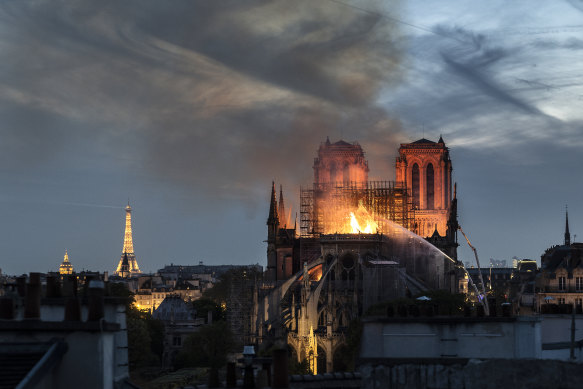
The April 2019 fire spread through the cathedral, collapsing its spire.Credit: Getty Images
After the fire, Notre-Dame couldn’t be traversed on foot safely. So Katz and his colleagues tied a microphone to a sewer pipe inspection robot and drove it through the burned cathedral. Comparing that measurement with the one from 2015 revealed that the space had lost a noticeable amount of its reverberation, a measure of how long sound takes to fade away in an environment. The holes in the ceiling were not the only reason; other changes, like the fact the building was now totally empty – emptied of pews, art and people – affected the sound, too.
Katz then created a computer model that “has all the material properties of everything at that time and gives the same kind of reverberation and sound quality of the cathedral”. If changes are proposed, he can modify the model to understand their effects on the acoustics.
To test the acoustics of the space at different points in the cathedral’s history, he and his team examined how a performance of Viderunt Omnes, by the French composer Pérotin, would have sounded. Pérotin was part of the Notre-Dame school of composition, which developed contemporaneously with the building of the cathedral in the 12th and 13th centuries. The Notre-Dame school was polyphonic, and in an organum like Viderunt Omnes, you might hear a chant embroidered with more colourful upper voices. These florid moments illuminate the chanted prayer, like golden margins on a piece of vellum.
To understand the interplay between the song and the historical acoustics, the group brought in experienced medieval singers to perform in an echo-free chamber. They have been testing the ornate lines of Viderunt Omnes in relation to the complex acoustics of the vaulted cathedral, which at the time of the song’s earliest known performance, in 1198, was yet to be completed. The height of the Gothic vaults would have allowed this polyphonic music to soar. The lower notes reverberate warmly, while the higher notes disappear more quickly in the space, allowing the audience to better hear the song’s complex music.
For much of Notre-Dame’s history, religious life was cut off from the secular world. Laypeople were separated from services by a large rood screen and would not have understood what was being said. Katz explains that for them, the words maybe didn’t matter as much. The prayer would have been in Latin, not French. Worshippers were expected to succumb to the voices, to be enveloped in their ceremonial mystery.
Any change in a space can have a large effect on sound. Despite the size of the cathedral, or perhaps because of it, “a very small change in some material, since it is propagated over hundreds of square metres, can have more of an effect than you would imagine”, Katz says. In comparing acoustical measurements from 2015 with ones taken in 1987, Katz found that even though the cathedral had not undergone any major alterations, the acoustics had changed. The likely culprit turned out to be a carpet strip that had been added to reduce the noise of footfall from tourists visiting during Mass. “That installation of the carpeting reduced the reverberation time a noticeable amount over that period,” he says. “This was remarked by the organist and the choir.”
The properties of materials like these will shape the sound of the cathedral when it is restored. “In the stone, you know, are they considering different quarries? Are they considering different materials?” Katz asks. “Are they considering different finishes? And all of those things could have an impact: is it a rough, porous stone, or is it more of a polished stone?”
In studying sound, researchers are not trying to make an exact copy but hoping to understand how a space functions. “There’s no perfect acoustics” for a space, Katz says, “but every action or every use has its ideal acoustics”. As he explains, “If I want to hear the singing of the clergy doing polyphonic music, as they did in the Middle Ages, there is an acoustic that’s best suited to that. If I then go forward to when the preacher is now preaching in a language known by the public, and I want to be able to understand it, that’s going to require a different acoustics.”
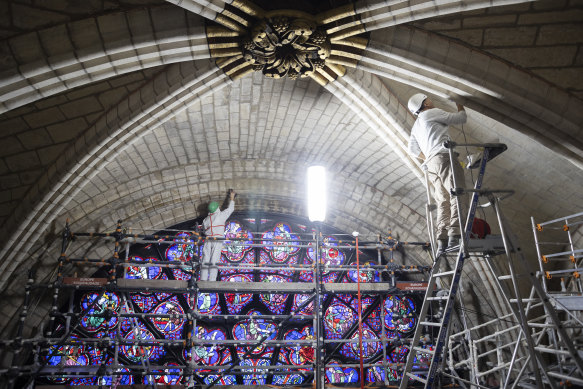
Restorers work on stones around Notre-Dame’s west rose window, which was originally completed in about 1225.Credit: Patrick Zachmann/Magnum Photos/Snapper Images
Even as researchers seek to reproduce an acoustical environment, some may use the opportunity to try to improve it. One such researcher is Angelo Farina, who teaches applied acoustics at Italy’s University of Parma and who, with colleagues, has made what he calls “acoustical photographs” of some 100 places, including churches and theatres, around the world. Farina, along with the researchers working on Notre-Dame, is part of a project called The Past Has Ears, which seeks to understand how sound and architecture interact.
In the 1990s, Farina made a recording of the Venetian opera house La Fenice by firing a blank pistol in the space. A short while later, the opera house burned down for the third time. (The opera house’s name translates to The Phoenix. This is not an accident.) Suddenly, he had a valuable tool: one that could be used to understand not only what a restored space should look like but also how it should sound. He had noticed that the acoustics of the original space made it difficult for the orchestra and singers to communicate. The audience loved listening to the concerts, but the performers were unhappy. When the opera house was rebuilt, he advocated addressing this issue and, eventually, slits were made to allow sound to pass from the pit to the stage. The singers could now hear what the musicians were playing.
Katz is looking to see if similar kinds of improvements can be integrated into the restoration of Notre-Dame. “The most recent ‘before’ is not necessarily the best ‘before’ in terms of acoustics,” he says. According to Katz, the Notre-Dame acoustics team and colleagues at the CNRS have conducted a series of interviews with current and past users of the cathedral, including “the priests, the organist, the engineers, the singers, basically everybody who has a vested interest in the acoustics of this space over, I’d say, the past 50 years”.
Of course, not everyone wants the same thing, especially in a space with so many conflicting uses. In the survey on the acoustic experience of Notre-Dame, respondents commented on the building’s unique sound. But the reverberation, which made listening to concerts a particularly moving experience, could create confusion and stress among the singers. They complained about not being able to hear one another and needing more time to rehearse when they performed in the cathedral.
As Katz and his colleagues note, acoustic parameters may be objective, but what matters to us in the acoustics of a building evolves over its long history. This meaning has as much to do with the sound itself as with the question of whose history, or whose past, we are trying to restore.
“The best ‘before’ is not necessarily the best ‘before’ in terms of acoustics.”
Many of Notre-Dame’s 12 million annual visitors have a precise memory of what they saw, what they felt, what they experienced inside the space: memories that shape their idea of what the cathedral is. But Notre-Dame has been worked and reworked over the course of its 900-year history, each time changing in architectural and political significance. At times, it has been a symbol of the French Church; at others, a symbol of the French monarchy. Today it is seen both as a centrepiece of French heritage and as an important draw for the tourism-dependent economy.
Almost every decision about the restoration of the cathedral has prompted an outcry because it is so difficult to agree on which cathedral to restore. The most recent version, which was heavily altered by the 19th-century architect Eugène Viollet-le-Duc? A more distant past? Or should the focus be a restoration that brings the fire into the building’s history?
Katz’s counterpart, Mylène Pardoen, who runs the other half of the acoustics research group, uses sound to better understand the history of a building. Pardoen calls herself a “soundscape archaeologist”, which means that she tries to hear the past. Her work consists of investigating what a moment in time would have sounded like and finding modern equivalents that allow us to experience it as accurately as possible. She combines individual recordings into what she calls “sound frescoes” in order to recreate the acoustic environments of particular spaces. She hopes that her sound frescoes of Notre-Dame, which will most likely be experienced through an app when the cathedral reopens, will help visitors appreciate and understand its history in a new way.
Though the decision was made to restore the cathedral to how it looked before the fire – including Viollet-le-Duc’s iconic spire – Pardoen’s project will span the building’s nearly 900-year history, in a kind of auditory excavation, an archaeology of sound. For Notre-Dame, she is creating eight soundscapes that capture different periods in the life of the cathedral, among them: 1170, when the choir was first being built; the beginning of the 13th century, when the full building was completed; and the present era. These moments represent turning points in the building’s history, and the combined soundscapes will illustrate this history in a new way.
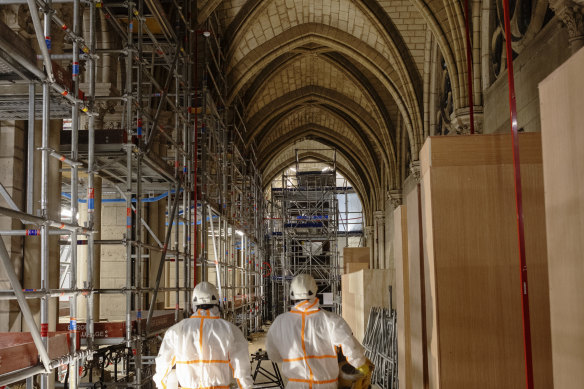
Dusting off the north tribune area shortly before the fire’s third anniversary.Credit: Getty Images
The cathedral had both holy and secular uses. Among the sounds a person might have heard across Notre-Dame’s various eras were the noises of the Parisian working class. There were even prostitutes soliciting inside, who, Pardoen told me, would click their tongues to attract customers; a sharp noise she demonstrated when we first met. We may see Notre-Dame as an eternal monument, but she hears it as a place that is always changing.
Many of the sounds she collects come from Guédelon, a castle about two hours south of Paris where she has been working to capture what a construction site like Notre-Dame’s would have sounded like. Guédelon looks like a normal French castle, but it’s new: the site was created in the late 1990s by a group of medievalists who wanted to see what it would take to build a castle using 13th-century techniques. The space is populated by carpenters, painters, blacksmiths, all dressed in period garb. Recording these workers has helped Pardoen understand the sounds that would have surrounded the cathedral during the many phases of its construction.
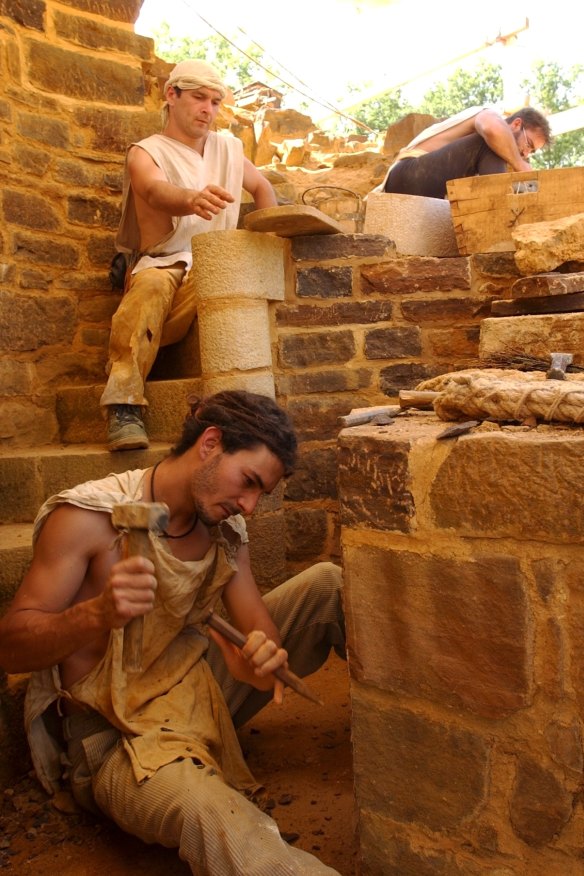
Audio sourced from Guédelon Castle, which is still under construction using 13th-century building techniques, will form part of a sound fresco for future Notre-Dame visitors.Credit: Getty Images
Every detail of that work would have shaped Notre-Dame’s sound. In Guédelon, Pardoen talked with the workers to understand how their materials would have shaped the auditory environment. As a blacksmith and his colleague pounded on a metal knife with two hammers, Pardoen and her associate recorded the movement, watching as the two men communicated via the din of their tools. In front of the castle, a man was walking in a large round wooden structure that looked something like a hamster wheel.
Pardoen explained that this is known as the “squirrel cage” and would have been used in the 13th century as a kind of crane for large construction sites. She moved on to record a man in a green tunic as he hammered together a wooden scaffolding.
At Notre-Dame, Pardoen hopes to provide a portal to the past by creating an archive of what she calls “immaterial heritage”: the noises and gestures of artisans who once built the cathedral and whose expertise, passed down through generations, is now being called on to restore it. She and Katz have also measured the acoustic properties of curtains, tapestries, paintings.
The individual findings can be integrated into Katz’s model of the building’s sound so the team can better test how historical sounds move through the space. To understand how Notre-Dame’s bells were heard from different positions, Pardoen travelled to the cathedral in Sens, south-east of Paris, and recorded the church bells from the outdoor plaza and at the bell tower. She then did the same at the altar with a microphone shaped like a human head, which her team dressed as a priest.
When I visited Notre-Dame with her, we were accompanied by a young sound engineer, as well as a historian studying metal. CNRS has eight groups working on the site in addition to Pardoen and Katz’s acoustics working group: groups specifically tasked with looking at wood, metal and other materials, as well as a group studying the emotions the site elicits.
As we climbed into one of the towers, Pardoen talked about her discoveries with a steeplejack, who showed off a 17th-century inscription he had seen. Working at Notre-Dame, she said, “there’s not a single day when you don’t have a little story”.
As I followed Pardoen, it occurred to me how much of the building draws feeling through its acoustics: the bell towers that face the city, announcing the presence of the church; the columns and walls that disperse sound to all the congregants. In their research, the scholars have questioned whether any of this sound was intentional or whether the particular ring of the cathedral is simply a melodious by-product of its construction. Yet every detail, every choice, even the ones the visitor never sees, adds to the particular music of the space. As we walked around, Pardoen pointed to the wooden structures in the bell tower that would support the swinging of the bells, containing their vibrations.
“It has never stopped being under construction,” Pardoen says of Notre-Dame. “When it is returned to the public, it will be white, luminous.” The space has always been a changing one. Heritage, she says, “is something that’s alive. And going through sound helps us give back some of that life.”
This is an edited version of a feature that first appeared in The New York Times Magazine.
To read more from Good Weekend magazine, visit our page at The Sydney Morning Herald, The Age and Brisbane Times.